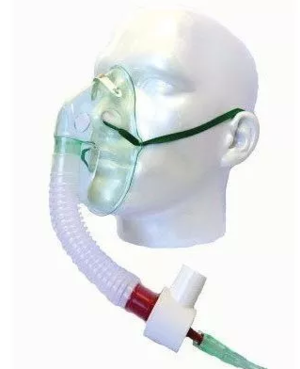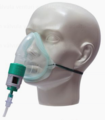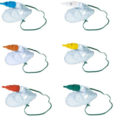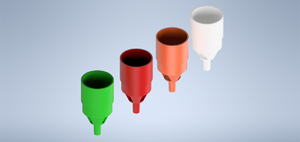Difference between revisions of "Venturi valves"
(→Considerations) |
(→Considerations) |
||
| Line 56: | Line 56: | ||
For design purposes, it is easier to have fixed concentration valves, which can be changed depending on the needs of each patient.The manufacturers of these valves present a table where they specify the oxygen concentration and the flow rate required that the oxygen must flow, depending on each type of valve, as shown below: | For design purposes, it is easier to have fixed concentration valves, which can be changed depending on the needs of each patient.The manufacturers of these valves present a table where they specify the oxygen concentration and the flow rate required that the oxygen must flow, depending on each type of valve, as shown below: | ||
<gallery> | <gallery> | ||
| − | Resp8.png | + | Resp8.png|thumb|Table 1. Oxygen antibodies |
</gallery> | </gallery> | ||
| − | + | The oxygen concentration depends mainly on the area A1, where the oxygen enters, and the area A2, where the ambient air enters. | |
<gallery> | <gallery> | ||
Resp5.png|thumb | Resp5.png|thumb | ||
</gallery> | </gallery> | ||
| − | + | The next pictures will give us an idea of some important parameters to have in count: | |
| − | |||
<gallery> | <gallery> | ||
Resp9.png|thumb | Resp9.png|thumb | ||
Revision as of 00:31, 19 March 2020
Contents
Project manager
| Maker | Image | Profile |
|---|---|---|
| Figueredo David |
Presentation
Attending to the global warming, in this project we want to combine our efforts to fight against the COVID-19 virus by creating a Venturi Valves system, used in the hospitals, which ones are starting to become scarce due to the number of patients. Due to this,we propuse to design and manufacture of said valves, using the 3D printing technology with the help of the UtopiaMaker community around the world.
Designs and blueprints
Design repository link: https://www.thingiverse.com/thing:4230375/files
Context
The main problem with th COVID-19 is the damage in the lungs, in short words this causes the alveoli get fill with mucous, hindering the breathing process (as a flu)
To help in the Breathing process, Venturi valves are used, and their function is increase air pressure and provide more oxygen to the patient, generating positive pressure.
For their operation, these valves are based on the venturi effect and Bernoulli's fluid law.
Análisis
In the next picture the breathing valve is show:
- In the joint P2 there is a negative pression, it makes than the enveriromental air gets into the valve and mix with the oxygen, decreasing oxygen concentration.
- If the A2 air inlet area gets bigger, more ambient air will enter to the system, decreasing oxygen concentration.
Considerations
There are two different types of valves: adjustable O2 concentration and fixed concentration.
For design purposes, it is easier to have fixed concentration valves, which can be changed depending on the needs of each patient.The manufacturers of these valves present a table where they specify the oxygen concentration and the flow rate required that the oxygen must flow, depending on each type of valve, as shown below:
The oxygen concentration depends mainly on the area A1, where the oxygen enters, and the area A2, where the ambient air enters.
The next pictures will give us an idea of some important parameters to have in count:
La entrada de oxígeno es para una manguera de 6mm de diámetro y la salida es para la máscara de oxígeno que tiene 22mm de diámetro. Teniendo en cuenta esta información, se pueden hacer las siguientes suposiciones de diseño:
- Al ser la manguera de 6mm y asumiendo un espesor de pared de 2mm, esto proporciona un rango de diámetros para A1 entre 4mm y 1mm; esto teniendo en cuenta que no sea posible imprimir un diámetro menor a 1mm con una impresora convencional.
- Entre mayor sea el diámetro 1 (D1), habrá más flujo de oxígeno a la válvula, esto siempre y cuando el caudal de aire sea mayor.
- Se sabe que entre menor sea el área A2, entrará menos aire ambiente y la concentración de oxígeno será mayor, al recibir todo el oxigeno directamente desde la máquina.
Con esas suposiciones, se diseñaron 4 tipos de válvulas:
- Blanca: se esperan concentraciones de oxígeno entre 24% y 28%
- Naranja: se esperan concentraciones de oxígeno entre 29% y 31%
- Roja: se esperan concentraciones de oxígeno entre 32 y 40%
- Verde: se esperan concentraciones de oxígeno entre 41% y 60%
Siendo los valores deseados los que se muestran en la tabla:
Diseño 3D
A continuación se muestran los diseños realizados:
Invitación
Este proyecto está aún en desarrollo, pero invitamos a todos los que puedan ayudar, a unir fuerzas para combatir este virus que está afectando al mundo, pensemos colectivamente porque solo juntos lograremos vencer y con pequeñas acciones, lograremos grandes resultados.














